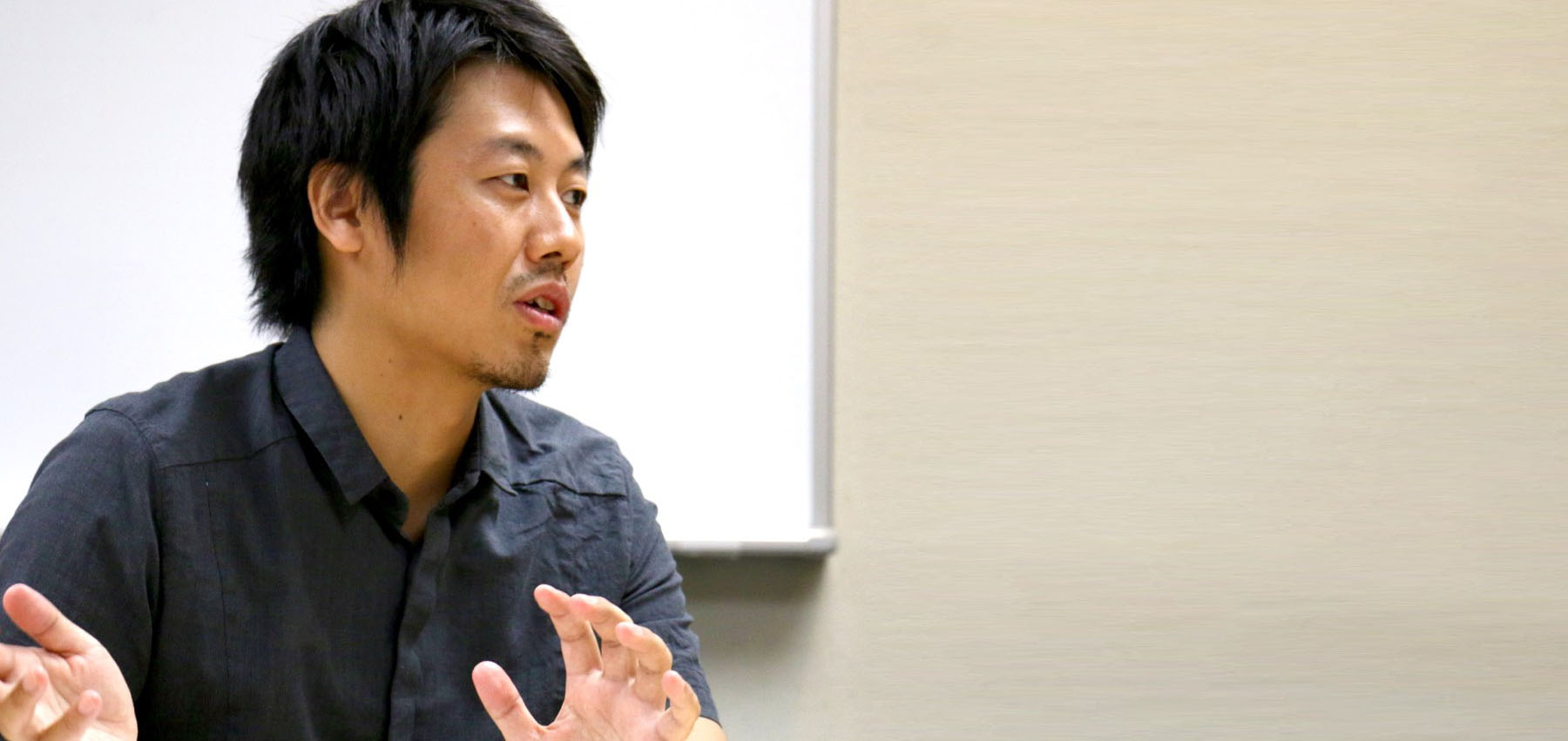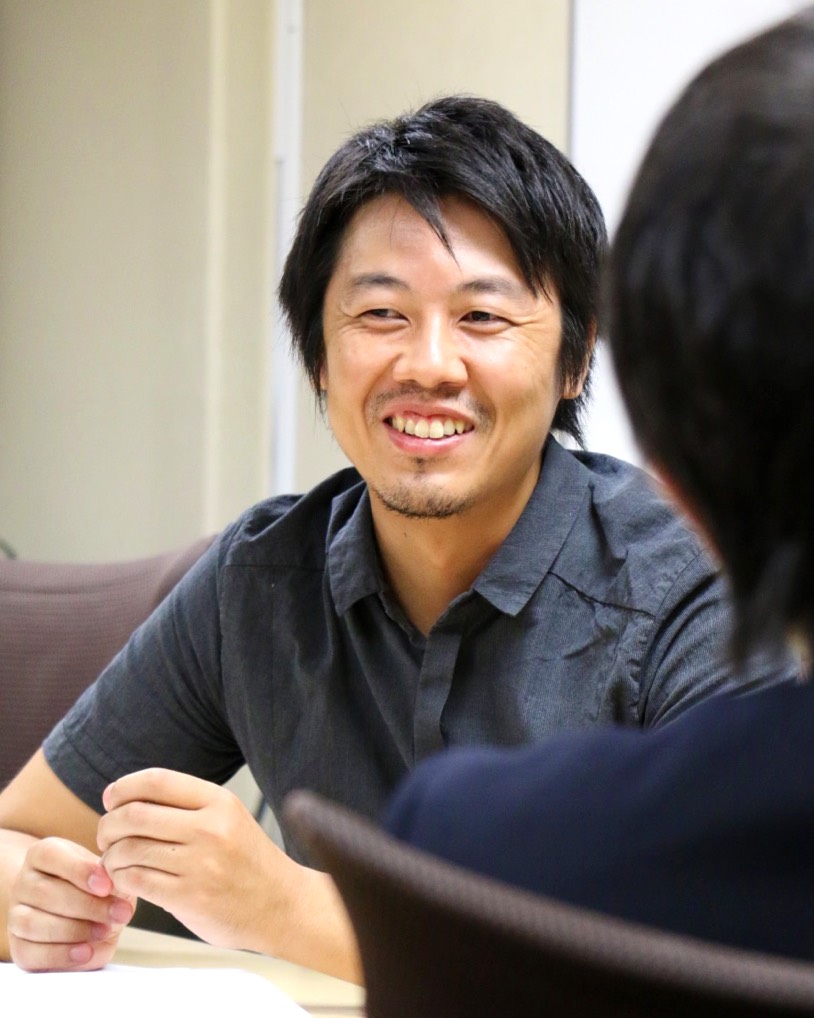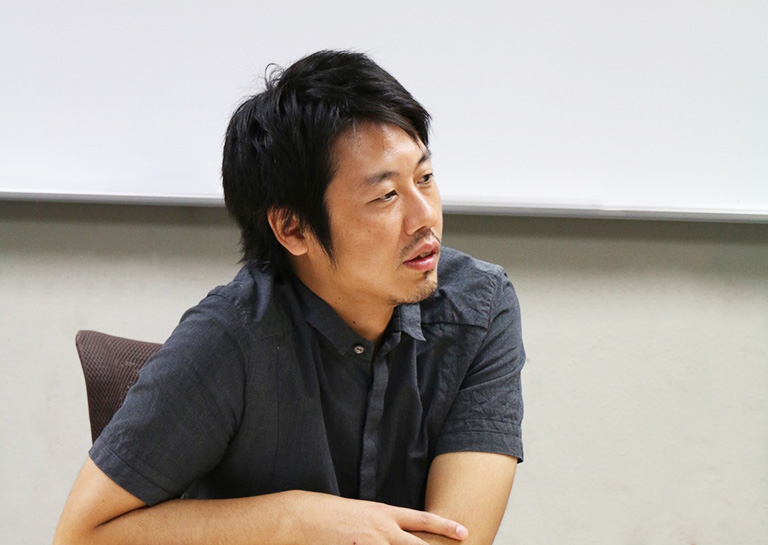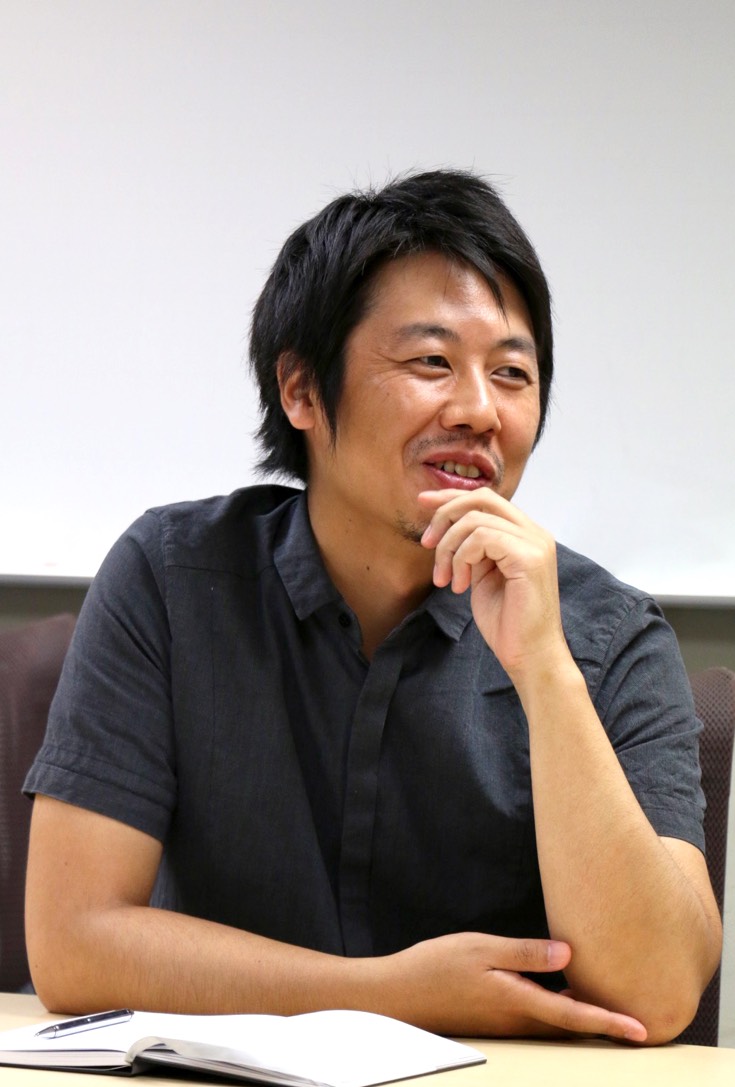
Vol. 2 / 2018.01.12
JUICE Player Interviews
from various perspectives
The roles of Japan and Professor Sekine in JUICE
——The second interview is with Yasuhito Sekine, Associate Professor at the School of Science, University of Tokyo, who is the JUICE-JAPAN pre-project science manager.
What was it about JUICE that led to your participation? And what are your aims with JUICE?

Dr. Sekine: The ultimate aims of my research are to clarify the universality of life in the universe. To put it simply, I am interested in whether there are living things outside of Earth, and how life came about on Earth. About 10-15 years ago, it was clarified that there is a liquid sea beneath the surface of the ice-covered icy moons. Obviously, this drew attention as it means there may be the possibility of life. Today, investigations are progressing that bring us one step closer to life, including analyses of the components of the internal seas, but such investigations have only been conducted overseas. One of the main reasons that I am participating in JUICE is that, this time, Japan is in the position of taking the lead rather than being a guest.
——What is Japan’s role in JUICE? And where should the focus be from now on?
Dr. Sekine: When thinking about “planet formation theory” (how the planets in the solar system came about), which is traditionally a strong point in Japan, Jupiter is an incredibly important planet. As to where Jupiter was formed, and the processes it passed through to reach its current position and size, this was basically determined by the formation of Earth and Mars and the processes of acquiring seas and an atmosphere, which may seem to be unrelated at first. That’s why it is important to study how Jupiter was formed in order to understand the solar system and the origins of the Earth.
Now, although the theory of Jupiter’s formation has not yet been fully integrated with actual proof based on observation, I think that, if they can be properly integrated, Japan, which has always been strong in the theory of planet formation, will be able to take one more step ahead of the rest of the world.
——As an external member of the Institute of Space and Astronautical Science, how are you involved in the JUICE Project? What are some points about the Project that concern you?
Dr. Sekine: Although I am of course just one Player, my position in JUICE is like that of a manager, if we are speaking in terms of club activities. As to what a manager is, it is about making the structures so that as wide a variety of people as possible participate in JUICE, and that new research is developed through their enjoyment of participating. My concern is that the mission of JUICE itself is still not yet widely or deeply understood by the researchers. I think that JUICE should become more established by building larger foundations through coordination in the field and by expanding to related fields, including universities. I am concerned because it is difficult to ensure continuity without such a large foundation. If we do have a large foundation, we can think about the aims from a wider perspective as to what we should next target, and, after JUICE, we can expand to other astronomical investigations such as Mars. The launch is still five years away, and the arrival will be many years after that, so, with the idea in mind of how to provide coordination, I think that we have to make connections with people outside the Institute of Space and Astronautical Science. I want to build strong connections to JUICE, including personal exchanges and the transmission of know-how, and strong relationships beyond JUICE.
and sharing our know-how
——Please can you tell us how the experiments and research related to JUICE will be promoted?
Dr. Sekine:
Speaking personally, I want to promote research that clarifies whether there are environments that can build life outside of earth. Specifically, I am interested in the seas inside the icy moons, rocks on the seafloor, and the ice that covers the sea, that is, the exchange of matter and chemical reactions in the boundaries at the top and bottom of the liquid sea. In such locations, matter that is not frozen inside the sea should be supplied from the rocks and ice. If there are any living things, it’s conceivable that they may be acquiring energy using the matter supplied from the rocks and ice in such locations. Therefore, we are conducting research in the laboratory to imitate or model the chemical reactions that occur at the limits of such exchanges of matter.
Specifically, there are reactions that occur in environments with 1300 atmospheres. Pressure at the seafloor of the Earth is about 300 atmospheres on average, but the high pressure at the seafloor of Europa is 4-5 times greater. Such pressure is greater than the Mariana Trench, which has the highest pressure on Earth. There is almost no such experimental data.
However, my laboratory has recently completed equipment that can create experiments in such conditions.
——This equipment can research what is happening by creating the actual environment of the seafloor of Europa for the first time ever, right?
Dr. Sekine: That’s right. We’re looking forward to the results in the future.
Personal exchanges beyond countries and disciplines

——You said earlier that Japan seems able to take one step ahead of the rest of the world with regard to the “theory of planet formation,” but what form do you think that progress will take?
Dr. Sekine:
The issue with current planet formation theory, especially, the theory of solar system formation, is that theory alone takes priority and there is little actual proof. The current appearance of the solar system could theoretically be formed through various paths. However, there must have been only one path. In order to know the actual path that was taken, it is necessary to thoroughly investigate the matter that has been left behind today on planets and moons. JUICE will obtain that evidence from Jupiter, which is the most important planet, and its moons. Thanks to JUICE, new theories of planet formation will be formed by aligning the theories with the evidence.
That’s not all. As the investigations proceed, there will undoubtedly be something that was not expected at first. For example, on Saturn’s moon of Enceladus, the fact that water from the internal sea is gushing out into space was first found by the Cassini-Huygens probe. Such unexpected things may also be found by JUICE. When such discoveries are made, it is important to always have a wide range of viewpoints, and to make structures to make inroads into new discoveries with speed and flexibility.
In Japan, where the communities are small, horizontal connections are considered to be important, and that forming horizontal connections should be easier than in countries with larger communities, so the idea is to expand such relationships by making use of this advantage that Japan has.
——Do the horizontal connections that utilize that the special qualities of Japan extend beyond the framework of scientific communities?
Dr. Sekine: Exactly. Physics, chemistry, biology and geology were arbitrarily determined by people, and with regard to the theme of “life in the universe,” for example, the borders between disciplines and scientific communities should actually be demolished. In other countries, there are such interdisciplinary research communities in connection to Mars, but this has not extended to the icy moons. As I spoke about earlier, there is still a barrier between theory and evidence with regard to planet formation theory. We want to start to combine these using JUICE. If we can unite them for solar system bodies such as Mars and the icy moons, we can go on to expand this to extrasolar planets. Alternatively, flexible exchanges may arise by starting out on scientific investigations of the solar system from extrasolar planets. We want to make wide-ranging considerations without limits.
——Right now, there is the “Aqua Planetology” Project that is being promoted by means of a research grant from the Ministry of Education, Culture, Sports, Science and Technology.
Dr. Sekine: That’s right. The Project is aiming to comprehensively understand how, “on astronomical objects that are related to water, that is, not only the Earth, Mars the icy moons and the small planets that are the destination of the probe Hayabusa2, as well as extrasolar planets,” liquid water is forming the surface environments of astronomical objects and how it is forming environments that may support life.
The icy moons are one of the most important parts of this. However, if the range is too wide, the problem is that it could backfire and come to an end without being narrowed down, so we want to find a balance that narrows down without becoming closed off.
——There is a tendency to divide people who make theories and people who use observed data, but what do you think about that?
Dr. Sekine: In Japan today, it’s true that the ratio of researchers who look at data is much lower than that of other countries, and I don’t think this is a good balance. The story of how this came about is complicated as it has a long history, but it seems that Japanese people tend to do whatever they can on a computer rather than using data. However, there is a limit to what can be done on a computer, and it is not possible to recreate the actual world in its entirety, so we should understand that it is important to look at the reality when finding proof.
——What methods are there to increase the number of researchers who can use data?
Dr. Sekine: Aside from support for activities in Japan, another quick and efficient way is support for international collaborative research. This includes sending young researchers overseas. I want them to understand from the level of the special characteristics of machinery equipped on Mars sample-return missions and Saturn probes, for example.
If young people who go overseas to learn data analysis come back as “missionaries” to teach students in Japan about data analysis, it will lead to more people looking at actual data. Such people will be the personnel who determine the landing sites for future Mars landing investigations conducted by Japan. If the status of the surface as seen from the space probe cannot be understood, the landing point cannot be determined. There may be a circulation of domestic and overseas personnel as cooperating parties start to participate in such Japanese landing studies, which would be an ideal situation.
Professor Sekine’s personal role in the field of science

——How do you view your position as a teacher within research?
Dr. Sekine:
In the larger flow of research, it’s hard to think about my own position. However, I’ve heard it said that “researchers should arrange their research life into divisions of 10 years across a period of 30 years,” and, taking on that idea, at the age of 30, I made my own position very clear by thinking about what I should do in periods of 10 years.
In the last 10 years, in order to look for an understanding of the possibilities of life outside of Earth, first, I found an understanding of the chemistry of the atmospheres and oceans of the individual planets and moons in the solar system. My scope of research covered a lot of ground, including the moons of Saturn, Mars and Pluto. At that time, I conducted research that involved people from geochemistry and geology. Rather than using my head, my research style was about being determined to get involved in the nitty gritty.
In the 10 years after that, that is, right now, I am planning to be engaged on the theme of understanding how more general astronomical objects with atmospheres and oceans evolve by combining an understanding of individual astronomical objects. With cooperation from many talented individuals, I am gradually forming a team.
Interest in life
——Regarding your interest in life, around when did your interest in the universe and planetary life come about?
Dr. Sekine: I entered the University of Tokyo because I was interested in evolution on Earth. I enrolled at the Department of Earth and Planetary Physics because I was interested in how the Earth and life on Earth interact, and in coevolution between the Earth and life. I want to know more about evolution on Earth rather than in space. I became interested in life in space and on planets when I enrolled in graduate school.
——Originally, you favored living things over an interest in the Earth.
Dr. Sekine:
That’s right. I used to look at picture books and go to zoos and the countries when I was a child because I liked living things. That’s what first motivated me, so I was concerned about whether or not to research Earth history, but the thing we understand the least about is the early part of Earth’s history, and, if I was going to do it, I realized that I wanted to do a job that started out from “Page 1” of the history of the Earth and life. That’s what gave me an interest in the origins of life.
However, the origin of life is an issue that, in practice, we must say that we do not understand. It’s really difficult to prove anything. We can build up assumptions, but even if we form life from inorganic substances in a flask, for example, there is no proof that this is what happened on primeval Earth. However, we may be able to prove that there is life outside of Earth, which we can determine be bringing back samples. By understanding the diverse possibilities of life and the requirements for starting life, I realized that we would get closer to understanding the situation of primeval Earth and the origins of life on Earth. The scope of my research gradually shifted from that to the universe.
Professor Sekine’s student days
——I would like to ask about what happened after you entered university. Was there anything that influenced you in particular in the lessons?
Dr. Sekine: In the sense of what left an impression from the lessons, it is Professor Hamano Youzou and Professor Kurita Kei who researched the evolution of the Earth’s metal core and mantle convection. As to why they left an impression, it is because they had a novel approach of viewing the Earth as a whole and taking an overview of the entire form rather than trying to explain just one phenomenon. University lessons explain the atmosphere, for example, by making neat divisions into the troposphere, stratosphere, mesosphere, and ionosphere, for example, but their approach was different. Their lectures left a deep impression as they took up a position in which everything from the Earth’s deepest core to the most distant ionosphere comprise a single interacting system.
About university students, graduate students and people in later stages
——Is there anything that you expect from university students or that concerns you about differences from your own student days?

Dr. Sekine: Students today have the privilege of thinking that “life in the universe” is an obvious theme. When I was a student, studies of the universe were basically centered on physics or geophysics. It’s still basically the same today but there is more proof from chemistry and especially from chemistry regarding the preliminary steps of life, matter cycles and geological proof. I’m jealous that they can start with the recognition that the theme of life in the universe is not science fiction but that it is a real science.
——It’s amazing that your research has become the foundation for young people and for human knowledge. Furthermore, is there anything that you think undergraduates and graduates should do?
Dr. Sekine:
I would like graduate students to have the experience of starting from scratch while they are in graduate school. Whether that’s with experimental apparatus or something else. It is incredibly important to be able to start on something new whether doing research or in society in general, and the experience of starting from scratch will lead to self-confidence.
I would particularly like to see that among PhD students if they are going to do physics in an era such as now when natural sciences are declining. If someone is going to go to the trouble of studying physics, their theme should be something essential, and by an essential theme I mean that it is necessary to combine disciplines. When at university, as long as you are unable to make something new for yourself, I feel that the discipline of natural sciences as a whole is just another part of general education. I’m not talking about research that comes to an end in two or three years but rather I would like them to make something from scratch to be left behind for the future history of mankind that does not imitate others. I want them to acquire the habit of starting out from something small or even from nothing at all and pushing themselves toward something new.
——What do you think are the important characteristics to move forward on a research path?
Dr. Sekine: Inquisitiveness. First, you’ve got to actually try it out.
——While fulfilling the role of choosing more difficult tasks in order to push the team in a positive direction, as a university professor, you’re also placing a lot of hope in the next generation. Thank you for your valuable words. We’re looking forward to the expansion of your research in the future!
Interviewed by Nishikawa, Nyan & Co.

